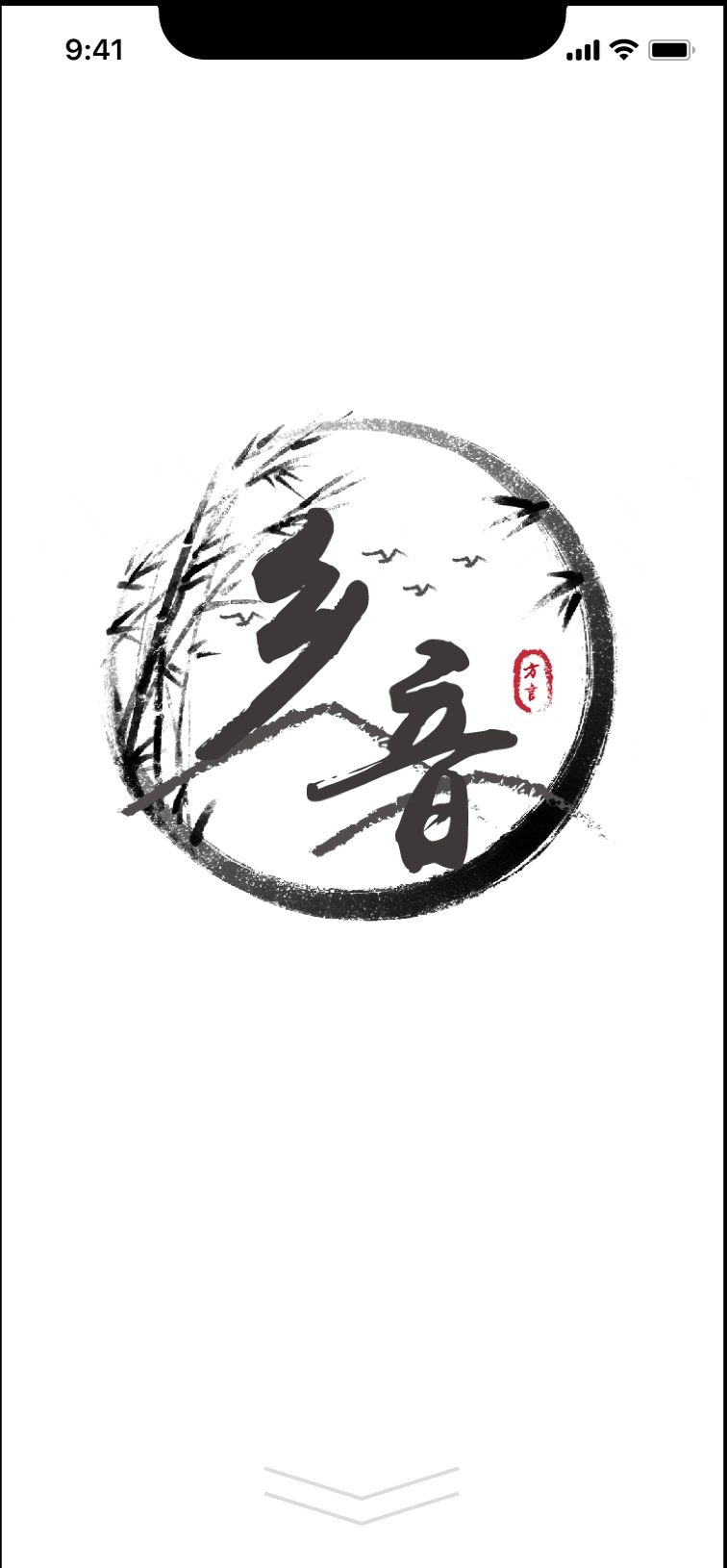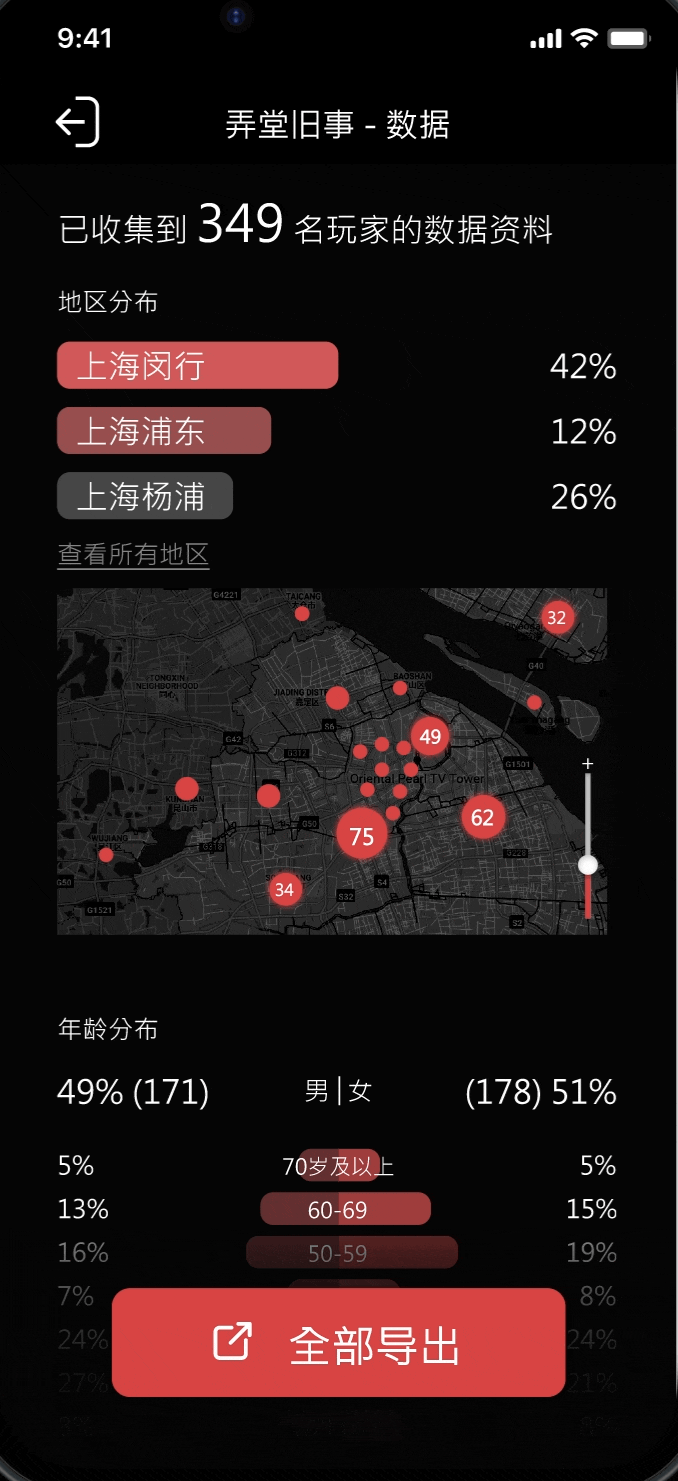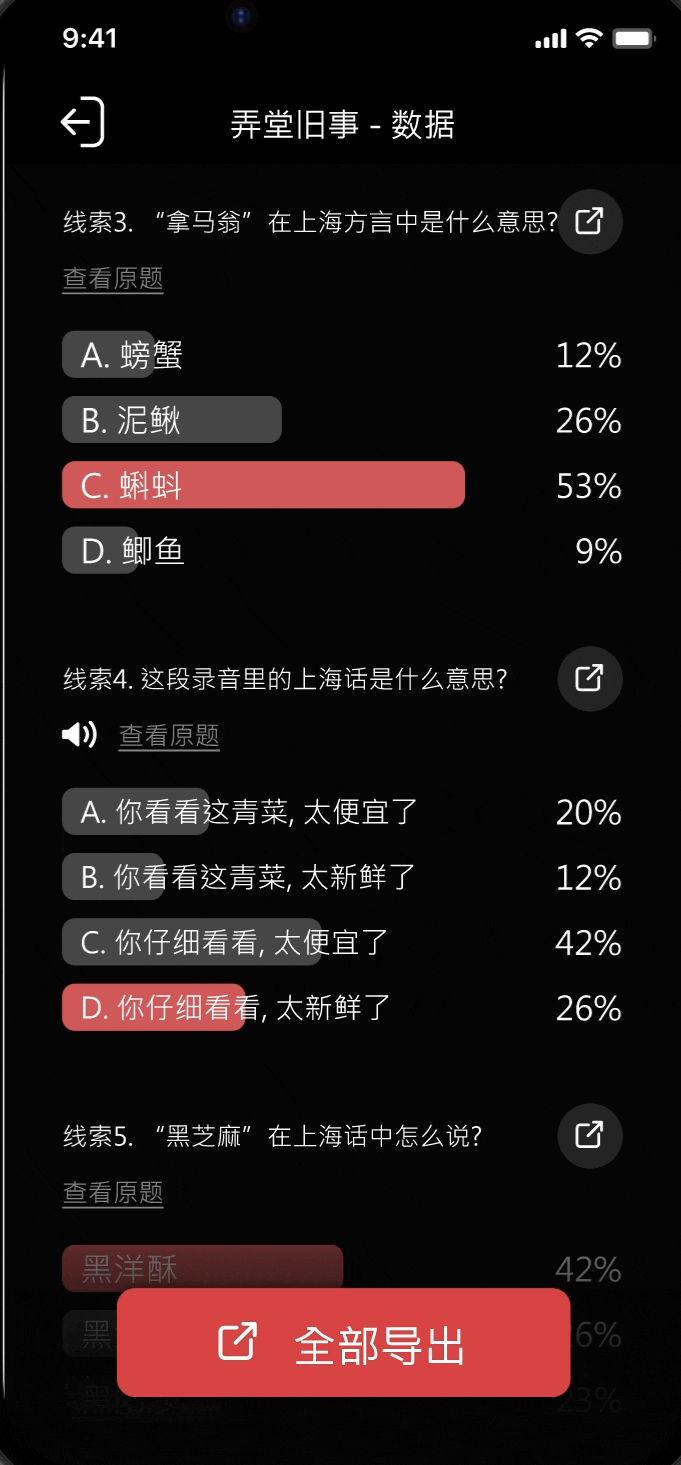

"Evanescence" is an interdisciplinary project that seeks to bridge the past into the future through the creative interweaving of social studies, architectural design, and UX/UI design. The goal is to provide a physical as well as digital channel/platform through which history, culture, past memories, and social identities could be recollected, showcased, disseminated, and rejuvenated.
01
Introduction to Team & Roles

Eric Li
Researcher, Architect, UI/UX Designer
-
Conducted surveys with Shanghai teenagers on their knowledge of Shanghai history and culture
-
Designed and curated a Shanghai culture pavilion that triggered cultural memories through a bike tour
-
Researched and compared existing dialect-sharing platforms and dialect-collecting tools
-
Prototyped a Wechat built-in for building an active community around dialect sharing and collection

Prof. Huang, He
Professor of Dialectology at FDU
-
Gave short lessons on the history and status quo of Chinese dialects
-
Provided guidance and feedback for the design of the dialect platform

Prof. Ling, Feng
Professor of Dialectology at SHU
-
Gave short lessons on the history and status quo of Chinese dialects
-
Provided guidance and feedback for the design of the dialect platform

PART 1.
Shanghai Culture Pavilion Program
02
Intention.
1
Ride, Ride, we ride on a boat, to grandma’s home…
My grandma used to sing this Shanghainese lullaby in my childhood and it continued to provide its pacifying effect as I grew up. Yet in a possible 30 or 40 years, this lyric would leave its mark only in the remote memory of history…
Growing up, though always surrounded by it, I've never realized the power and importance of history and culture to our people. It was in a casual conversation with my mom when she expressed a little discontent, in a lightly wistful tone, that “young people in Shanghai could not even speak Shanghainese, nor do they know about Shanghai history or culture”.
Is our history and culture doomed to evanescence? With this question in mind, I began my project by delving into how exactly young people are interested in and familiar with Shanghai history and culture.
Research on Cultural Knowledge






Methodology.
2
Questionnaire
-
Divide Shanghai young people into age groups (middle & high schools, university)
-
Distribute questionnaires to each age group (100/school 5 school/age group)
-
Retrieve and calculate statistics (including mean, standard deviation, max/min)
-
Make comparisons (from other provinces?), analyze statistics, make conclusions
Will questionnaires be enough?
Questionnaires provide only rough estimate of the entire population. Besides, we cannot know the underlying motives/reasons behind the data.
No!
Options?
Tete-a-tete conversations with my close friends can provide much more veracious and detailed information for understanding the status quo.
Interviews
3
Questionnaires & Interviews.
-
Cover a range of topics on Shanghai culture.
-
Provide accurate analyses of subject knowledge.
-
Show clear tendencies & important study hints.
-
Be a little entertaining to keep them interested.
Questionnaire Sample
-
Prioritize veracity & minimize suspicion rate.
-
Take geographic factors into consideration.
-
Ask how subjects can learn Shanghai culture.
-
Ask subjects relevant follow-up questions.
Interview
Sample
4
Results & Solutions.
Based on the results of the questionnaires, I discovered three important insights:
-
Findings indicate students lack basic knowledge of Shanghai history and culture ( Avg. < 76.8%)
-
Results polarize with those from top schools doing significantly better than others.
-
Students know more questions relevant to experience (food) than those more abstract.
From the interviews I learnt that the number of avenues/resources to learn Shanghai history and culture is quite limited. A tough issue is the tremendous cultural conflicts they experience here - students from other provinces are more likely to keep their traditions instead of mingling with local customs. But the biggest problem remains that many Shanghai adolescents still dismiss the importance of preserving Shanghai culture.
To solve the issue of both lack of knowledge and limited access/opportunities, I first came up with traditional modes like adding Shanghai history and culture to school curriculum or providing public lectures. But finally, I took a novel approach of designing a Shanghai pavilion that serves as a cultural hotspot.


Questionnaire & Interview Samples

Questionnaire Result Sample
03
Site Choice: The Bund
The Shanghai culture pavilion, whose shape is inspired by the Chinese character "shen 申", the old name of Shanghai, would host a variety of cultural displays, exhibitions, and activities that seek to evoke historical memories of Shanghai. Choosing the site for my pavilion is important to exerting cultural influence. We finally decided on Fuzhou Road, the Bund as our ideal site for the following reasons:
Near History.
1
Called "Exhibition of World's Architecture", the Bund is well-known for its diverse architecture, where every one has a rich hisotry to tell.
Near Young People.
2
Assorted shopping malls, restaurants, and recreation centers at the Bund receive a daily flow of hundreds of thousands of young people.
Visible from Pearl Tower.

Pearl Tower
The Bund
3
The pavilion can be seen clearly from the Oriental Pearl Tower. The tower provides a chance for young people to be impressed by the "shen" shape of the pavilion when visiting.
Site Plan
Pearl Tower
Fuzhou Road
The Bund

View of Pavilion from Pearl Tower
04
Experience Design: Bike Tour
Dumpling-Inspired Bike Design
These bikes are carefully designed to attract young people. Their basic structure is a tricycle. A more elegant frame and a fancy dumpling-shaped shield form the back and give the bike a more modern and fun sensibility.
In order to physically and mentally engage young people to my pavilion, I designed a bike sightseeing tour that enhances the pavilion's cultural and societal influence. Our carefully designed bikes would be distributed around the Bund and are driven by tour guides (or by visitors themselves). On the way to the pavilion, the tour guide can introduce different Bund architecture and elaborate on their histories.
When reaching the pavilion, a track belt system would move the bike through the pavilion's helix gallery, where a number of memories of old Shanghai would be displayed in both visual and audio forms. The whole experience culminates when the bike arrives at the pavilion atrium, where more cultural items such as paintings and sculptures are showcased, and where group activities and public lectures on Shanghai culture and dialect regularly take place.
Pavilion Gallery.

05
Pavilion Design:
Drawings
Axonometric
Roof
Circulation
Walls
Floor Plan - Ground Level
Floor Plan - Second Level
Elevation



PART 2.
Chinese Dialect Platform
China, with 7 major modern Chinese dialect groups and over 300 different dialects (even without counting different accents), enjoys the fame of one of the world's richest linguistic repertoire. Due to complex social and personal reasons, however, the number of (young) people speaking dialects and their home tongues is drastically declining, most severely in Wu dialect regions like Shanghai and Suzhou.
Various efforts have been made to preserve Chinese dialects. A common method used by scholars is called "caifeng", where they would often go visit local people (e.g. in rural areas) and collect audio materials. Such methods, however, have not been efficient or systematic. Besides technical difficulties (including explaining to people how the method works), the effort of going through towns and villages is not commensurate with the actual results due to limited sample sizes. Plus, these methods do not impact how the younger generation speaks or uses dialects in their daily life. As professor Huang said, these efforts would only slow down the evanescence of certain dialects--still one day, they would be studied like history.







Dialect Learning Apps on the Market:
Lacking attraction and engagement and method of collecting/aggregating resources for scholars

06
Background Research on Dialects


Photo and Collected Sample of "Caifeng":
There lacks systematic approach of collecting, synthesizing, and storing resources on dialects
Disappointed yet determined, I set my sight on another domain--dialect learning apps. I searched for and compared existing dialect learning apps and built-ins on the market. Unlike "caifeng" or dialect collecting approaches that mostly serve academic purposes, these apps face a much broader user base. Nevertheless, majority of users would still be people who already have interest or experience in speaking and learning dialects (mostly middle-aged or elderly). In addition, there is a great emphasis on educational purpose, similar to other language learning apps like Duolingo, and conversely a disconnection with dialect scholars/experts and people looking for fun and interaction.
To merely preserve or "salvage" Chinese dialects, to me, is not adequate, as it is no different from displaying antiques behind glass curtains. Luckily, the rise of social media apps like Wechat provides an opportunity to engage young people in actively using dialects and raise their cultural awareness, to finally "rejuvenate" Chinese dialects.
07
Introducing
Design Solution


Based on my background research, it became clear that the primary design problem is to tackle the disconnection between dialect scholars/experts and the general public. Dialect scholars/experts want to increase their resource pool for collecting dialect-related materials, and this can only be realized by enhancing the level of engagement and interaction of people, especially the younger generation, in using and learning dialects. The dialect-speaking population can be further divided into "active creators", who are experienced "dialect maniacs" that actively engage in online conversations and creating social media contents on dialects, and "audience/players", who are less interested or experienced in dialects but are fond about interactive media like videos/games.
This leads to the introduction of my final solution--"xiangyin 乡音", an interactive community-based Wechat built-in that aims at arousing interest and awareness in Chinese dialects while collecting research-aiding dialect materials. The name "xiangyin" means "sound of hometown", a literary and nostalic expression for "home language". I made the decision of making a built-in for Wechat because I wanted to take advantage of the influence of Wechat while circumventing the competition with dialect learning apps and inconvenience of downloading another app.
Once the user launches the built-in, a preference question is asked whether he/she wants to be a "player", "creator", or "expert". Based on the user's selection, the built-in's content is adjusted accordingly: for instance, experts have access to text/verbal recordings and other data analyses in a game, and creators are encouraged and facilitated in their video/game production.
1
2
3




Activity.
From videos, games, to Murder Mystery, users can enjoy watching and playing a variety of activities around or in the form of Chinese dialects. They will be feeded the most recommended based on their history records, or the most popular ones based on click rates or ratings. They will also be able to create their own (described later).
Community.
Users can select a "hot topic" by pressing or searching a keyword, such as "Shanghai dialect", and popular posts would pop up based on the user's selection. Users can then look at what others, including their friend, have been heatedly discussing or experiencing around the topic, and join their discussion by simply pressing "reply", "favorite", or "forward".
Chat.
Users, especially experts, can chat with one another or create chat groups to share materials or other things. This is useful for keeping the conversation to be only around "dialects" and protecting privacy (since Wechat is already a social app).
08
Interaction Highlights

My Space.
A creative workspace for dialect-related content & media.




Favorite.
Export
Users, especially "players", can view their favorited activities on the "favorite" page, where the activities are listed in chronological order (topmost the most recent). It helps players to replay the game or view the latest updates.
Create
Users, especially "creators", can create and publish their own games, scripts, and animations, following the "plus" button on the "create" page, where the app itself makes it easier for users to create activities on Chinese dialects. Once submitted, the activity will be reviewed by selected experts who make sure the contents are safe and correct before it goes fully published. Users can always check the status of their activity (green: pass, yellow: pending, red: not pass).
"Expert" users, once exporting the dataset of an activity (described later), can view their exports and the materials themselves on the "export" page. The exports are listed in chronological order and a red "latest" sign would remind experts of the most recent export.
Game Play.
Fun, interactive, and learning experience of engaging with dialects.


Before Game
Some vivid game description...
Players are told what they need to prepare for this game, such as basic knowledge requirement, and whether to turn on their mike during the game (so that their answers can be recorded for future uses).
"View the data" will be only visible to "experts", which includes all the information that have been gathered so far from players (age, location, correctness, audio materials...). This will be shown in the next page.


During Game
Example of a timed task: players are asked what an expression means in a dialect. The question is supplemented by an audio material that helps players recognize the term.
Example of an untimed task: players are asked to sing a lyric / read a poem in their dialect and need to press the "audio" button to record their voices.

After Game
Players will be asked one or two concise questions after game play. This question can be: in what situations are you prone to speak your dialect? (with families, friends, at workplaces...). This will be extremely helpful for experts.
Data Export.

One-click export of all materials, aggregate data, & analytics.


At the start of expert feedback, some metadata about the game will be shown, including but not limited to the number of players so far, geographical distribution (visualized by colored dots on the map), age/sex distribution, and the situations for using dialects (based on the follow-up question). These metadata would provide a clear overview of the dataset without much effort by the expert.



Following the metadata, experts will be provided detailed data analysis for each task in the game and, depending on the question type, be provided audio materials (including a "trial" audio that the expert can choose to listen). The expert can export the data for each question as a single file (like excel) or export all data (including metadata) as a whole package.



By clicking on the red button ("export all"), the expert can export the data with the choice of either as local folder or an online workspace (such as Tencent Folder). The expert can download any time with updated data.

